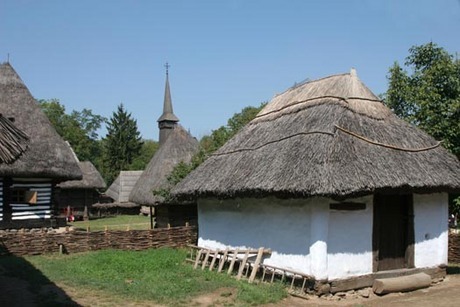The Village Museum
The Village Museum was established in 1936 and it contains over 300 wooden houses, windmills, churches etc. from all over the country. If you don't plan to visit Romania's rural areas - and even if you do - you shouldn't miss this museum which is one of the largest of its kind in Europe. Many of the buildings are originals which were brought here in pieces and reassembled. The oldest houses date as far back as the 17C. Behind the project from the start was ethnographer Dimitrie Gusti (1880 - 1955) who wanted the museum to mirror as closely as possible the aspects of the rural life. Because of this the museum is organized as a real village, with clusters of houses being linked by winding paths. This makes for a pleasant stroll especially if you find yourself in Bucharest during the summer, when the city is hot and dusty. Sometimes the museum hosts crafts fairs and folk music and dance festivals. Address: Soseaua Kisellef 28 -30.
Anyone who has ever felt lost in a cavernous suburban living room will probably appreciate why Susanka claims that many modern homes are not built at a human scale. Susanka argues that we ought to ditch many of the formal rooms, like the dining room and living room, because people don't use them and tend to hang out in the family room and kitchen instead. She favors open-plan living, especially for the family room, kitchen and dining areas, with design elements, like soffits, used to provide psychological separation between adjoining rooms.
The Village Museum in Bucharest, one of the most original and fascinating museums that I have experienced in a long time, contains an amazing collection of original peasant homes drawn from around Romania. Despite the very small incomes of their occupants, they are warm homes. The many different Romanian peasant homes on display all incorporate many of the ideas outlined by Susanka.
Spaces are designed more multiple uses--unsurprising since most homes only have two rooms. Colorful special items, like dresses and rugs, are displayed on the walls of the house to personalize it and add decoration. Beautiful, intricate details, like carved wooden fenceposts and gables characterize the homes. Susanka would also admire the instinctive sense of architectural proportion.
One might hope that a Not So Big House would be Not So Expensive. However, all those details which were once affordable even to Romanian peasants are now very expensive in the United States. Natural woods and personal detailing are anything but cheap. All that quality in a Not So Big House costs just as much as the space in a quantity house. Susanka's comfy homes aren't for the poor.
Nicolae Ceausescu, Romania's Communist dictator until he was overthrown and shot in 1989, also had strong opinions on architecture. However, Ceausescu was a member of the Bigger Is Better school of thought. He favored shoddily built modern apartment blocks over traditional peasant homes. As part of his "modernization" plans, he forced the consolidation of many villages into new towns made up of poorly-constructed apartments.
Block after block of Bucharest is dominated by what appears to be the same dreary, gray apartment building replicated over and over again. One would think that a country would at least pick an attractive plan if they were going to repeat it endlessly but that wasn't Ceausescu's style. However, far from coincidentally, people are a lot easier to watch in apartments where they live cheek-by-jowl with their neighbors, including spies for the Securitate--Romania's infamous secret police.
Ceausescu concluded his reign by destroying much of Bucharest's incredible architectural heritage. Inspired by Kim Il Sung's North Korea, Ceausescu knocked down over 9000 of Bucharest's beautiful nineteenth-century architecture to contruct the Centru Civic, an area of socialist realist architectural blight. The central artery of the quarter, the Bulvardul Unirii, is dominated by the vast Palace of Parliament - the second largest building the world after the Pentagon.
Romania, a land of some 22 million souls, now has a parliament building larger than any other. Unfortunately, the exterior has all of the inspiration of the usual monstrous socialist wedding cake building. The interior is comparatively tasteful though the countless oversized rooms, vast amount of marble and numerous chandeliers smack of Vegas. Even as the population literally froze during winter in unheated homes as part of Ceausescu's crazed effort to save money and pay off Romania's external debt, resources poured into the building project.
Though over 700 architects worked on the project, Ceausescu and his wife oversaw construction of the building personally. Work was often expensively redone at their whim. Incredibly, the lead architect, who bears the grandiloquent name of Mira Anca Victoria Marculet Petrescu, now sits in the parliament as a member for the fascist Great Romania Party.
Some Romanians still get angry when they see the building because it reminds them of Ceausescu and is yet another example of how "grandiose monumental buildings have priority over the needs of the population." However, others are grudgingly learning to like the Palace of Parliament which is constructed wholly by Romanians out of Romanian materials. It may be ugly but it's theirs. And Romanians are nothing if not proud of Romania.




